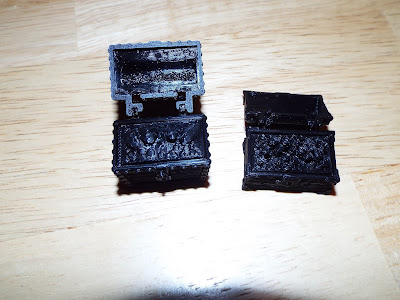A year has already passed. I've tried to do one post every week this
year, and while I had to occasionally miss a week here and there, I
think I managed to write about a lot of different things this year.
Most of it was advice no-one really asked for (hope someone out there
found it useful), but I also had the luck to do my fair share of
reviews this year. The interesting part about products is that
despite liking them, and appreciating them, you sometimes just find
yourself not using them after a while. Small, not very obvious things
just add up, or you get bored when over time. For this reason I hope
to look back at my reviews, and the products I used to highlight
those that I feel deserve an end of year shout out. So, let's get
into it.
Official Dungeons & Dragons
We had 3 books released this year: Xanathar's Guide to Everything,
Tomb of Annihilation, and Tales from the Yawning Portal.
They were generally solid. Xanathar's Guide to Everything
being very much a supplement book. Tales from the Yawning Portal
was for those of us who wanted to see some of the old D&D
adventures, which of course made it less tempting if you owned the
original unless you wanted an updated version. My favourite of the 3
was Tomb of Annihilation, but I've always been a sucker for
adventures that also work as adventure supplements. They give me a
lot of material to reuse or steal, a new adventure to run and also a
large degree of control, unlike a new Player's Handbook, for
example. I can control what comes my players come across, where supplements often are harder to reign in.
3D Printing
The end of the year saw me finally being able to 3D print. And at
this point I've had the chance to 3D print a whole slew of tiles, and
props. The ones that I've used the most so far are the Rampage System
and
Dragonlock.
The ease of printing for Dragonlock made it a favourite of mine, and
the modular nature of rampage also made me like them. I still haven't
decided which way I'll go but I've been enjoying them both so far. In
terms of props, the Black Scroll Games chests have been my by far
most used 3D printed props this year. Even 2D printed maps are made
better with props so it isn't much of a surprise to why I ended up
using them so often. The ability to switch the inserts as needed
was extremely useful during play and made them even more useful.
Modular Inn Tiles
I reviewed this set in December of 2016, but over 2017 I used it
quite heavily. Before my foray into 3D printing, I used it whenever I
needed an inn battle map. Since starting 3D printing, I still use the
tiles extremely often. They are just so much easier to print and
provide very good visuals. 3D printed tiles often need to be painted.
The Modular Inn tiles can just be printed in colour. Nice and easy.
As an aside, I'd recommend printing dungeon tiles using white
filament to help reduce or eliminate the need for painting if they are meant to be stone. It'll
look slightly worse than a properly painted one but will be more usable than pitch black ones
like mine. I also don't have the 3D printable sets that allow you to
print buildings, so instead ended up re-purposing tiles meant for
underground dungeons. That works fine, but it doesn't have the same
level of detail as the specialized tiles and takes far longer to set up than the 2D tiles. In comparison, I
could print off some tiles, tape them together, and be ready to roll.
I could also quickly just set them up on the table and not need to
worry about laying out all the props. I did still use a few props,
most commonly chests, but I didn't need to completely fill the room
in when going to somewhere else for my session. They were instead
highlights. When running sessions in my house and using 3D tiles, I
could just set things up ahead of time at the time. No problem. Where
it got more difficult is when adding new rooms that also needed
plenty of props. Either I'd connect the empty room and needed to add
the props, or I'd connect the room with the props which caused them
to shift. These issues weren't present with the Modular Inn
tiles and allowed many different configurations. They are my
favourite of all the sets I reviewed from Black Scroll Games so
far.
Next Year
We've got a whole new year ahead of us. We'll get some new Dungeons &
Dragons 5th edition stuff, of that I'm sure and I'm
definitely curious. Black Scroll Games also had a successful
kickstarter for Cities of the Black Scroll,
which looks great. What's not to like about enough printable tiles to
make yourself a bulletproof vest?




